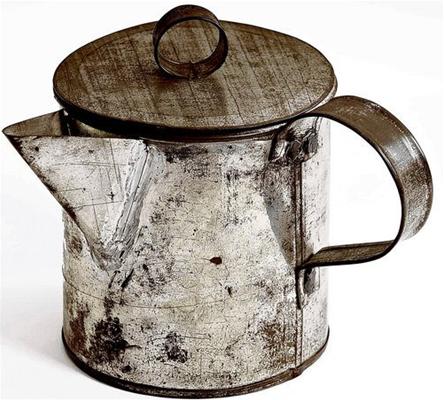
Emigrant's Teapot, late 19th to mid-20th Century. This humble object tells two stories of wandering people. It is a tin teapot, with a pouting lip soldered on to one side and the internal wall of the cup punctured with holes to make a strainer. It was made in Tuam, Co Galway, by an old tinker, Mike Maughan, and collected in 1961. But Maughan was responding to a request to make the kind of vessel that his family had traditionally made for 19th-century emigrants. Preparing for the long sea voyage to North America, and unwilling to do without the tea for which the Irish had acquired an insatiable thirst, emigrants would buy these specially designed vessels. They were made by travelling people in an era before “tinker” became a term of abuse. The deftness of the object suggests that the Travellers were well attuned to the market for their goods. It is telling that Irish folk culture developed its own objects specifically for the act of emigration. The sheer scale of outward migration in the decade of the Great Famine is staggering: 2.1 million people. More people left Ireland in 11 years after the famine than during the previous 250 years. Many left on what Thomas D’Arcy McGee first called “sailing coffins”, and many were ragged, famished and diseased. About 300,000 of them settled permanently in Britain, especially in ports such as Liverpool, about 340,000 went to Canada and 1.5 million to the US, smaller numbers settled in Australia, New Zealand and South Africa. But even after this first wave of refugee migrants, Irish people continued to leave in droves, impelled not by hunger but by the push of poverty and the pull of urban industrial life. In the 65 years between 1856 and 1921, between 4.1 and 4.5 million adults and children emigrated. (Passenger lists show large number of children travelling alone.) It is especially striking that, almost uniquely, Irish emigration was as heavily female as male – the Irish maid (and later the Irish public-school teacher) were as much stock figures in American life as the Irish navvy or publican. Emigration came to be an expectation. Children, wrote one observer, “learn from their childhood that their destiny is America; and as they grow up the thought is set before them as a thing to hope for.” Ironically, the leaving of Ireland became one of the real markers of Irish identity. Leopold Bloom, in James Joyce’s ‘Ulysses’, asked to define a nation, says it is “the same people living in the same place”. The remarkable fact was that the Irish, scattered among the continents, did retain some sense of being “the same people”.



